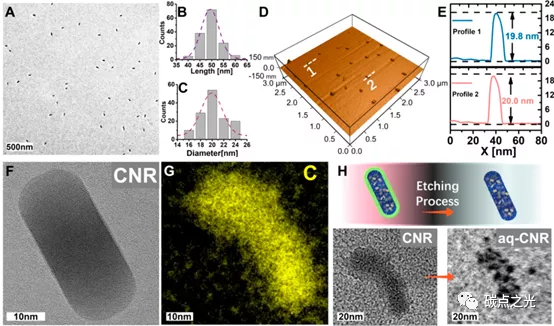
hotline:
17715390137
Tel/Wechat:
18101240246 (Technology)
0512-68565571
Email:mxenes@163.com (Sales Engineer)bkxc.bonnie@gmail.com
Scan the code to follow or search the official account on WeChat:
2D Materials Fronrier After paying attention,
click on the lower right corner to contact us,
Enter enterprise WeChat.
Professional Services Online

For a long time, the scientific community has regarded various carbon-based nanomaterials (fullerenes, carbon nanotubes/nanowires and graphene) as non-emissive or weakly-emissive materials. Compared with traditional II-VI colloidal quantum dots, carbon dots (CDs) have the advantages of strong versatility of starting materials, simple manufacturing process, biocompatibility and environmental friendliness, and the absence of heavy metal ions and toxic elements in the synthesis process . Although spherical CDs have been known and extensively studied, there are no reports in the literature on strategies for preparing elongated analog CDs (ie, light-emitting anisotropic carbon nanorods). Most of the strategies for preparing nanorods are quite complicated (such as arc discharge, electron beam induction, chemical vapor deposition, etc.), and the carbon nanorods (CNR) produced are mostly synthesized in the micrometer length range.
Considering the current trend of using semiconductor nanorods in display applications, there is an urgent need to develop new synthetic routes to obtain carbon-based anisotropic nanoparticles. The team of Professor Andrey L. Rogach of City University of Hong Kong published an article on ACS Nano under the title of "Chemically Synthesized Carbon Nanorods with Dual Polarized Emission". Using xylene as a solvent, using citric acid in a hydrophobic solvent, it is not easy to dissolve and tends to form aggregates. The surfactant aminopropyl isobutyl silsesquioxane is used as an encapsulating agent. Preparation of carbon nanorods (CNR) with a length of 50 nm and a width of 20 nm. Their anisotropic shapes are determined by using aminopropyl isobutyl silsesquioxane, and their optical properties are derived from the domain of polycyclic aromatic hydrocarbons incorporated into the inorganic framework. CNR shows dual-polarized emission with a quantum yield of 15-20% and an emission anisotropy of ~0.3, which changes from blue (460 nm) to yellow (565 nm) according to the excitation wavelength. CNR exhibits different colors and emission The anisotropy is adjustable, and the anisotropy is the highest at longer excitation wavelengths.

Figure 1: Carbonization and reverse micelle formation during CNR synthesis

Figure 2: Characterization of CNR

Figure 3: PL spectra of CNR under (A) 365nm and (B) 450 nm parallel and vertical excitations, (C) CNR absorption spectra detected at two different wavelengths 460 and 560 nm are in the same direction as PLE Compared with the opposite spectrum.
This new approach develops a monodisperse CNR with a relatively high optical anisotropy factor (0.3). The emission anisotropy is comparable to conventional CdSe nanorods, but it is cheaper and less toxic. In addition, the reported CNR shows emission anisotropy in the blue region, which is not easy to achieve for many conventional semiconductor nanorods. Its availability is expected to further promote the application of fluorescent carbon nanomaterials in optoelectronic devices (including liquid crystal displays, photodetectors, and three-dimensional (3D) display systems). In addition, they may also be used as luminescent probes in biological systems, each of which Anisotropic kinetics may be affected by the local cellular environment, and thus become a probe of the local cellular environment.
Article links: Xiong Y, Zhang X, Richter A F, et al. Chemically synthesized carbon nanorods with dual polarized emission. ACS Nano, 2019, 13(10): 12024-12031.
https://pubs.acs.org/doi/abs/10.1021/acsnano.9b06263
Source of information: Carbon Point Light
This information originates from the Internet for academic exchange only. If there is any infringement, please contact us to delete immediately

| Reminder: Beijing Beike New Material Technology Co., Ltd. supplies products only for scientific research, not for humans |
| All rights reserved © 2019 beijing beike new material Technology Co., Ltd 京ICP备16054715-2号 |